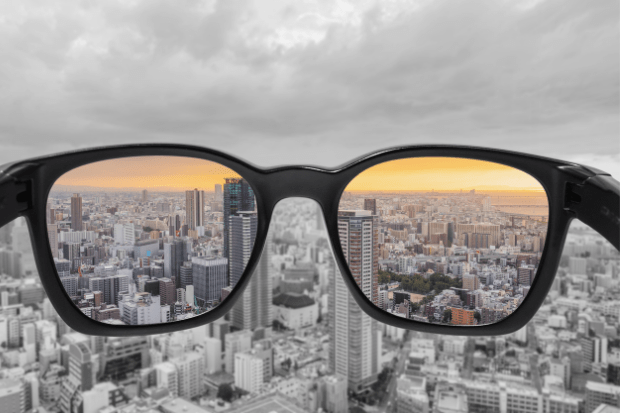The Latest Technology in Prescription Glasses and Lenses

Just like any occupational field or any complex product, eyeglass lens technology is ever-changing. Today’s glasses wearers are presented with more lens options and customizations than ever before. Innovative lens technology provides the wearer with optimal, digital, precise vision. We will discuss the latest technologies available for eyeglass wearers.
Evolution of Prescription Glasses and Lenses
As early as 1200, Venetians used rock crystal, made into convex shapes, to improve near vision. In 1301, the superintendents of Venetian Arts allowed the craftsmen to make “Vitreos to oculis ad legendum“ which translates to glass lenses for reading. Soon after, the first eyeglasses were made with two round, biconvex lenses and assembled with a rim of metal or wrought leather riveted together at the handles. However, it wasn't until the end of the last century that glasses became an expression of an individual’s style and personality.
Latest Technological Innovations in Prescription Glasses
Prescription lenses have evolved past rock crystal. The latest technological innovations in prescription glasses include customization and personalization, novel lens materials and coatings, and smart glasses. In addition, 3D-printed lenses may potentially improve the lives of patients with low vision or color blindness.
Customization and Personalization
The progressive lenses of 2023 are more custom and personal than decades prior. Freeform lens technology has many advantages over conventional progressive lenses. Digital freeform lenses provide better optics for the wearer. Software programs are used to analyze the prescription, pantoscopic tilt, and frame fitting position to create a custom lens.
Freeform lenses are premium progressive lenses because they provide a wider field of view and less peripheral distortion. Patients do not have to move their head up and down or side to side as much as they would with a conventional lens. They are less likely to feel motion sickness or as if they are inside a fish bowl.
Today’s lens designs take into account the digital world we live in. Americans spend more time on their phones and computers each year, and more recent PAL (progressive addition lenses) types have a widened intermediate segment for device use.
Advanced Lens Materials
Trivex and high-index are two types of advanced lens materials for eyeglass lenses. A Trivex lens is a lighter, thinner lens but is as impact-resistance as a polycarbonate lens. The vision will be clearer through a Trivex lens when compared with a polycarbonate lens. Trivex is best for children's glasses, sports glasses, and safety glasses. Those with a prescription between -3.00 and +1.50 should have their lenses made from Trivex.
High-index lenses are the thinnest lenses available for those with higher prescriptions and thicker lenses. A high-index lens bends light, reduces distortion, and provides the highest optical clarity. High-index lenses are recommended for patients with a prescription equal to or greater than -4.00D or +2.50D. High-index lenses are available in three indexes: 1.60, 1.67, and 1.74. Keep in mind that the higher the prescription the bigger the difference in lens thickness when high-index materials are compared and optically, the lower index lenses such as 1.60 will have better performance with similar thickness as a 1.67 index lens.
Lens Coatings and Treatments
The following lens coatings and treatments can be applied to any lens material.
Anti-reflective coating
Anti-reflective (AR) and blue light lens coatings are designed for the visual demands of daily life, especially digital device use. Anti-reflective coatings offer the best visual experience by reducing glare both on the lens surface and from back-lit devices. Your eyes can also be viewed more naturally through a lens with an AR coating, improving your appearance. Additionally, the halo effect around car lights and the reflections off computer screens/TVs are also reduced with the addition of an anti-reflective coating.
Some studies show blue light coatings may be beneficial in reducing eye strain. Digital device users often suffer from digital eye strain or computer vision syndrome. Common symptoms include blurry vision, headaches, dry eye, and neck and back aches.
Superhydrophobic coating
A superhydrophobic coating applied to eyeglass lenses makes the surface water-repellant. If you are caught in the rain, the lens will repel the water droplets and reduce fogging. Those who live in a cold or rainy climate may want to consider this coating. Chefs or restaurant staff who enter freezers or work over a hot stove will also benefit from the application of a superhydrophobic coating.
Oleophobic coating
An oleophobic coating is applied to a lens surface to repel oils and grease. Fingerprints, for example. This coating is considered “anti-smudge” and is often found on smartphone and tablet screens, camera lenses, smartwatches, and car windshields. Prescription lenses with this coating are easier to clean and will stay clean longer.
Anti-static coating
An anti-static coating reduces debris like dust and dirt particles from sticking to your prescription glasses. Eyeglass lenses with an anti-static coating will also be easier to clean and remain clean longer. If you work outside or in a dusty environment, you may want to consider an anti-static lens coating.
UV protection coating
A UV protective coating is very important for eye health. An invisible dye is added to the lens surface to block the sun’s rays from your eyes. UV exposure from the sun is a risk factor for developing cataracts, age-related macular degeneration, and eye and skin cancers. Lenses made of plastic will block most UV light, but adding an additional UV coating will increase the UV protection to 100 percent. Polycarbonate and high-index plastics have 100 percent UV protection inherent in the lens, so an extra UV coating is unnecessary. Photochromic lenses also block 100% of UV light without an additional coating.
Anti-scratch coating
An anti-scratch coating doesn’t prevent your glasses from getting scratched, but it does harden the lens surface for improved scratch resistance. All patients, especially children, benefit from an anti-scratch coating because accidents do happen! Unfortunately, it's easy to drop your glasses and get a scratch right in the middle of your line of sight. Most types of eyeglass lens materials, including high-index, polycarbonate, and Trivex, have an inherent anti-scratch coating, but if you order another lens material, you may need to add it. Scratch coatings are applied to both the front and back surface of the lens and help to extend the life of the lens.
Sun Lenses Advancements
Polarized lens
A polarized lens is a special type of sunglass lens with a filter to eliminate glare and allows light to pass through in only one direction. Polarized lenses enhance contrast, reduce glare, and make colors pop! Polarized lenses are available in several colors and are ideal for fishing and skiing.
Photochromatic lens
Light adaptive or photochromatic lenses, often branded as TransitionTM lenses, change from a clear lens to a tinted lens with sun exposure. Light adaptive lenses are available in several tint colors and can be polarized. Light adaptive lenses are convenient because you don't have to carry both clear lens glasses and sunglasses.
Technological Advancements in Lens Design
Computer lenses and office lenses are fairly new developments in lens technology. Both lens types are often recommended to patients as a second pair of glasses. Though both types have a little amount of distance viewing in the lens, the majority of the lens consists of the intermediate and near portion of the lens. Someone who sits at a desktop computer, or has multiple monitors, is an ideal candidate for one of these lenses. The difference between the two being the computer has around 5 feet of distance while the office lens has up to 10 feet of distance. The computer has a little more reading, and the office has a little more distance. Neither lens is meant for driving.
Anti-fatigue lenses have been developed in the last five years. The lenses are designed for digital device users who may need a little extra magnification for near work or to relax their eyes when using their device. Patients around the age of 40 who aren't ready to move to a progressive lens or those under 40 who feel eye strain may benefit. Anti-fatigue lenses can have a near add of +0.50 to +0.75. Your eye doctor will add this component to your glasses if testing shows it will be of benefit to you.
Smart Glasses and Augmented Reality

Many manufacturers are producing smart glasses. Some even work as augmented reality devices that allow the viewer to project a computer screen to the corner of the eye. Some smart glasses are able to answer calls, control your smart devices, play different media, record videos, and take photos, and they integrate with your social media. Google, Amazon, and Ray-Ban already have a version of smart glasses. Apple is the latest company to introduce its own version, which is expected to launch in 2026 or 2027. It is unknown at this time if a patient’s own glasses will be needed or if Apple’s lenses will allow for internal adjustment for the patient’s prescription.
Future Trends and Possibilities
A patent for producing 3d printing optical lenses was first issued in 2015. 3d printing was first used to produce prescription glasses but has evolved for augmented reality glasses. The software, VisionPlatform, first owned by Luxecel, printed lenses using layers of acrylic-based resin and tailoring each lens to different prescriptions.
Between the layers of resin, the printer can embed smart devices into the lens, using waveguides and LCD screens to provide the user with an AR experience. Meta, owned by Facebook, acquired the company in December 2022 to improve their augmented reality glasses.
In the future, it is possible for 3D-printed lenses to be manufactured specifically for patients with specific eye conditions. For example, if a patient with macular degeneration has lost parts of their central vision, the 3d lenses can be designed with the vision moved to the remaining parts of their central fields. Scientists have also developed 3D-printed lenses to benefit the color blind. The lenses are created from a translucent resin tinted by combining it with two wavelength-filtering dyes and were customized using three different dye concentrations.
Conclusion
Prescription lens technology continues to change and evolve at a rapid rate providing eyeglass wearers with more crisp and precise vision. Patients have more custom options for their visual demands, occupation, and hobbies than in decades past. From novel lens materials and coatings to 3D-printed lenses for the color blind, we have much to look forward to!
